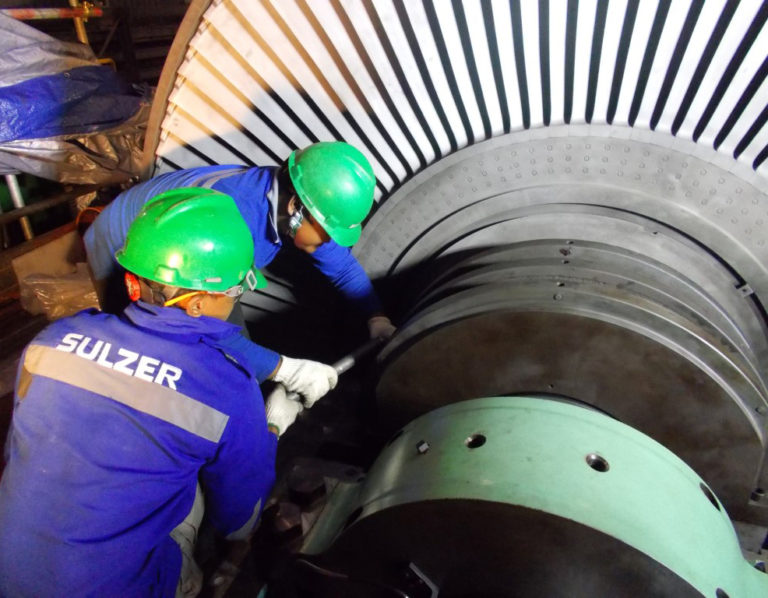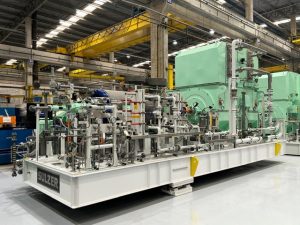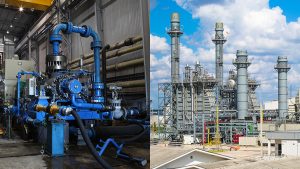Remote geothermal steam turbine inspection completed in record time

Reassembling the turbine gland seal housing bolt. (Image source: Sulzer)
Steam turbines need to be inspected and overhauled on a regular basis as recommended by the manufacturer; keeping downtime during this work to a minimum is important to the productivity of the power plant.
Electricity powers both domestic and industrial life and there is more and more pressure to increase the amount of power generated through renewable sources. As such, geothermal power stations are fulfilling this need, but the way in which they create power means, quite often, they are located in remote, mountainous areas. For maintenance teams, this can present a considerable challenge, one that Sulzer has resolved by mobilizing the essential tools required.
Minimizing downtime
In Indonesia, geothermal energy is receiving considerable investment in an effort to expand the number of power plants and take advantage of the country’s natural geology. Having installed the pumps, steam turbines and generators, it is important to complete the planned maintenance schedules to ensure continued reliability.
One site in West Java, operating a 60 MW generator, was looking to complete a scheduled biennial inspection and overhaul on the steam turbine as well as the hot well pump and the generator itself. The on-site maintenance team expected this to be completed within 20 days so when Sulzer submitted a proposal to complete the work in 14 days, this was considered favorably.
Sulzer submitted a comprehensive tender that detailed all the work that would be completed and a timeline that would save the power station a considerable amount of downtime. The timing was of great importance because the outage has to be planned well in advance so that other generating facilities can cover the reduction in generating capacity.
Remote maintenance service
Sulzer offers a comprehensive range of services to power stations of all types, with most of the work being completed in its fully equipped service centers. However, in Indonesia, the location of the geothermal sites can make access difficult, so Sulzer has developed a specialist mobile service that can be deployed to the power stations.
Having been awarded the contract to complete the maintenance work, Sulzer planned the project down to the last detail in conjunction with the on-site team. In all, Sulzer had 120 personnel at the power station who worked two shifts to minimize the downtime and deliver on the promised completion date.
In this case, the installation was only four years old, so no major faults were expected, but Sulzer planned to conduct a comprehensive inspection, report any defects and repair them if necessary. The first stage was to transport all of the equipment and tools required for the project up the mountain roads in preparation for the outage.
Microscopic inspection
The inspection of the steam turbine involved opening the casing and removing the rotor so that it could be examined closely, cleaned and measured. In this case, the rotor blades were sand-blasted to remove any debris, while the bearings were measured for dimensional accuracy. In addition, the engineers carried out a penetrant test and magnetic particle inspection on the bearing journals.
At the same time, an inspection of the hot well pump was carried out as part of the project to replace the bearings, which were supplied by the customer. Even though the instrumentation fitted to the pump showed no signs of a fault, the investigation found a deviation on the pump top bearing housing, which was out of tolerance. This required the bearing housing to be shipped back to the local service center to allow it to be repaired.
Using specialist high velocity oxygen fuel (HVOF) coating equipment, the repair team built up an additional layer of material that was then machined back to the original specifications of the manufacturer. This ensured that the bearing housing diameter was now an interference fit and suitable to go back into service with the new bearings in place.
The hot well pump is an important part of the geothermal process, comprising a vertical pump with an impeller diameter of approximately 1’500 mm. Without prompt attention, this fault could have developed into a more serious situation, causing more damage and resulting in an unplanned outage.
Successful re-start
Fortunately, the inspection of the generator and the electrical tests concluded that there was no need for any remedial action, allowing all the equipment to be reassembled. Having recommissioned the turbine, the power plant was able to start generating again within the 14 days quoted by Sulzer.
Kusno Baryadi, Field Engineer for Sulzer in Indonesia, concludes: “Our ability to deliver essential periodic maintenance to these remote locations offers customers a considerable saving in time. In this case, the customer was very pleased that Sulzer had saved them nearly a full week of production.”
Source: Sulzer Ltd.







